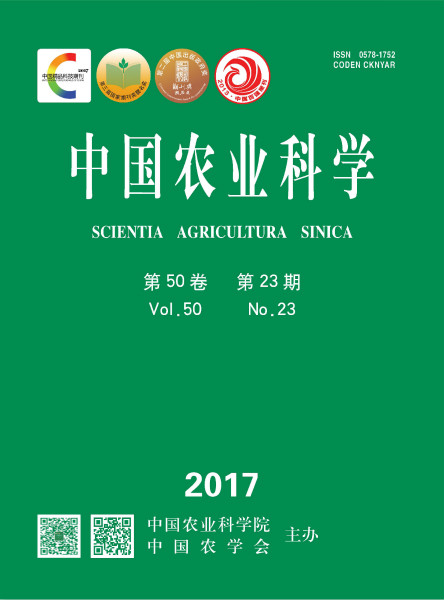-
Effects of Gibberellin on Migration and Colonization of Rhizobia and Seedling Growth of Alfalfa
- MIAO YangYang, SHI ShangLi, KANG WenJuan
-
Scientia Agricultura Sinica. 2017, 50(23):
4545-4557.
doi:10.3864/j.issn.0578-1752.2017.23.008
-
 Abstract
(
371 )
Abstract
(
371 )
 HTML
(
3 )
HTML
(
3 )
 PDF (408KB)
(
471
)
PDF (408KB)
(
471
)
 Save
Save
-
References |
Related Articles |
Metrics
【Objective】The objectives of this study are to determine the effect of gibberellin on the migration and the colonization dynamics of the two fluorescent tagged rhizobia in Gannong No.5 alfalfa (Medicago sativa L., Gannong No.5) tissues, and also to determine the effects of the combination treatments on alfalfa seedlings growth, so as to the results will not only enhance the colonization ability especially in reproductive tissues, but also provide benefits for alfalfa cultivation.【Method】The effect of gibberellin on the rhizobia growth (OD600) were detected at 1, 3, 5, 7 and 9 d after the day of adding gibberellin; the migration and colonization of rhizobia in alfalfa tissues of 15, 30, 45 and 60 day, and seedling growth were also investigated by drenching root with the inoculant of rhizobiaEnsifer meliloti 12531f (12531f) and Ensifer meliloti LZgn5f (gn5f), which were added with 0.5, 1, 10 and 100 mg·L-1 gibberellin, respectively.【Result】The results showed that, under 10 mg·L-1 and 1 mg L-1 gibberellin level, 12531f and gn5f could grow better than other levels, but did not have significant effects. The two fluorescent tagged rhizobia could migrate to the aerial tissues and well colonize lower stems, upper stems and upper leaves by adding 10 mg·L-1gibberellin into 12531f treatment and added 1 mg·L-1 into gn5f treatment, respectively. The fluorescent tagged rhizobia could not be detected in the control (sterile distilled water) treatment. Inoculating 12531f and gn5f alone increased the leaf chlorophyll content, while the addition of gibberellin inhibited the leaf chlorophyll content, but the individual plant nodule number, individual plant nodule weight, individual plant leaf number, plant height, root length, aerial dry weight, and root dry weight were increased highest when added 10 mg L-1 and 1 mg·L-1 gibberellin into 12531f and gn5f, respectively. When 10 mg·L-1 gibberellin added into inoculant of 12531f, the individual plant nodule number was higher than that of control and single inoculated 75.71% and 11.82%, respectively, but there were no significant difference (P>0.05). the individual plant nodule weight was significantly higher than control and single inoculated 1 136.11% and 55.05%, respectively (P<0.05). the individual plant leaf number was significantly higher than control and single inoculated 113.94% and 78.28%, respectively (P<0.05). the plant height was significantly higher than control and single inoculated 83.33% and 50.24%, respectively (P<0.05). the root length was significantly higher than control and single inoculated 115.28% and 29.17%, respectively (P<0.05). the aerial dry weight was significantly higher than control and single inoculated 214.27% and 206.43%, respectively (P<0.05). the root dry weight was significantly higher than control and single inoculated 1 156.19% and 1 049.53%, respectively (P<0.05). When 1 mg·L-1 gibberellin added into inoculant of gn5f, the individual plant nodule number was higher than control and single inoculated 82.86% and 4.07%, respectively, but there were no significant difference (P>0.05). the individual plant nodule weight was significantly higher than control and single inoculated 697.22% and 105.00%, respectively (P<0.05). the individual plant leaf number was higher than control and single inoculated 32.12% and 19.13%, respectively. the plant height was higher than control and single inoculated 95.24% and 37.82%, respectively; the root length was higher than control and single inoculated 76.39% and 5.83%, respectively, but there were no significant difference of these data (P>0.05). the aerial dry weight was significantly higher than control and single inoculated 125.98% and 121.80%, respectively (P<0.05). the root dry weight was significantly higher than control and single inoculated 864.43% and 762.21%, respectively (P<0.05).【Conclusion】These results suggest that 10 mg·L-1 gibberellin and 1 mg·L-1gibberellin promote the migration and colonization of 12531f and gn5f in alfalfa seedling, also enhance the number of nodules and leaves, and promote the growth of plant height, root length and biomass, indicating that suitable gibberellin might be exploited to promote the migration and colonization of rhizobia in alfalfa tissue and positively impact growth and yield.









